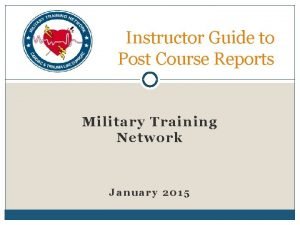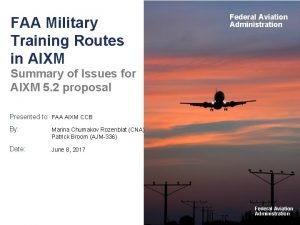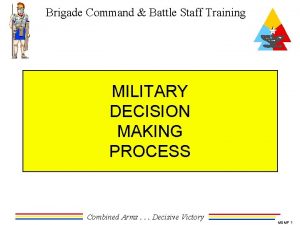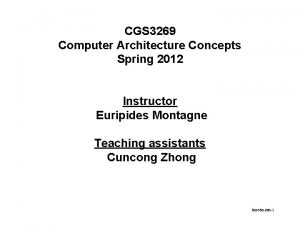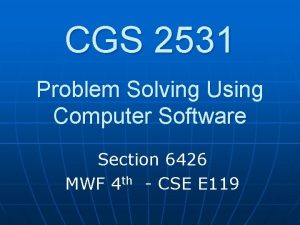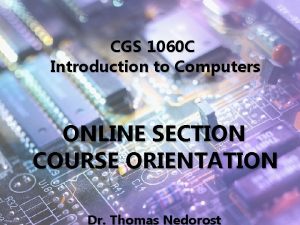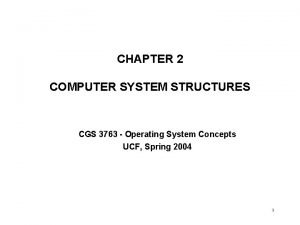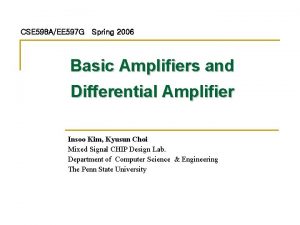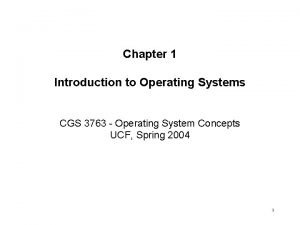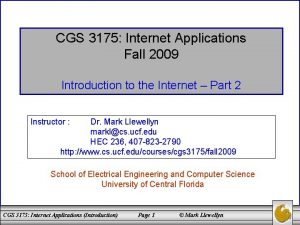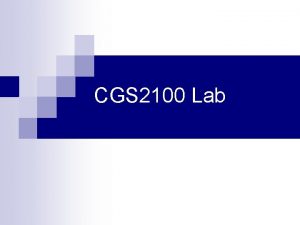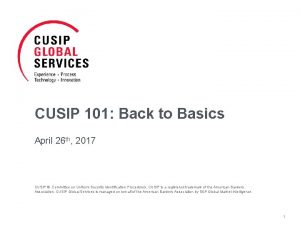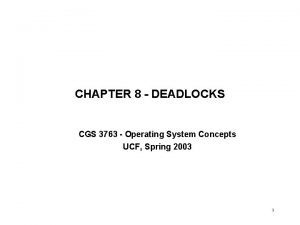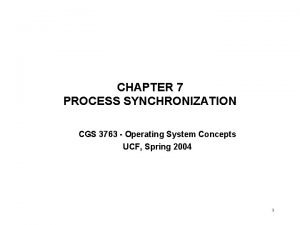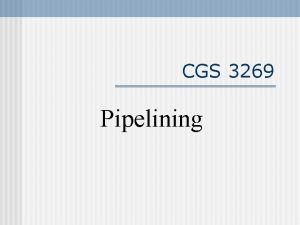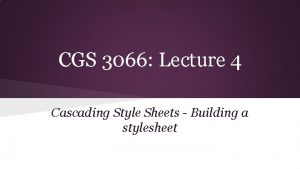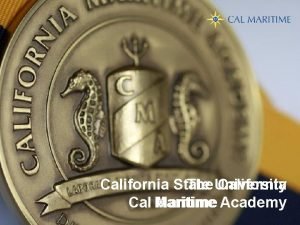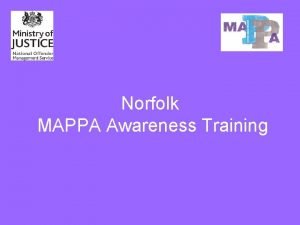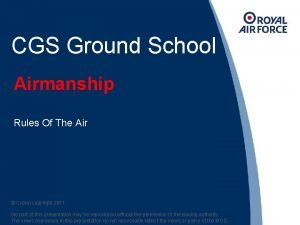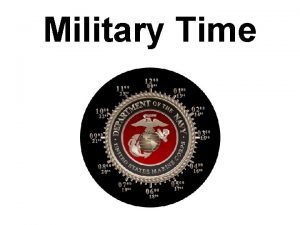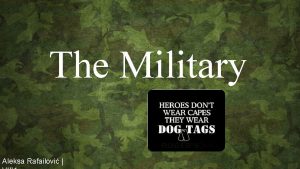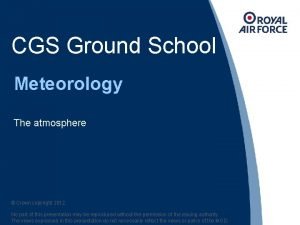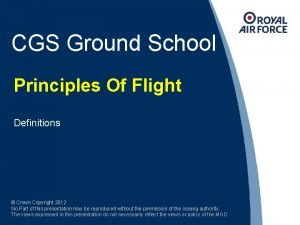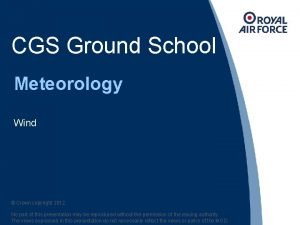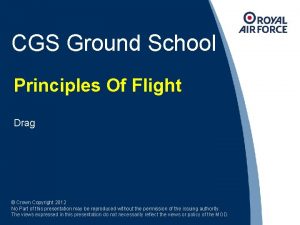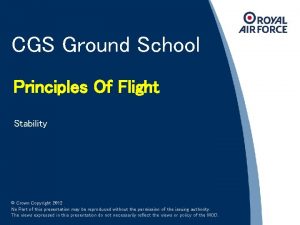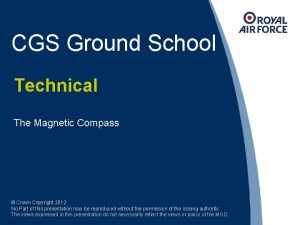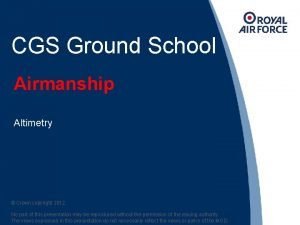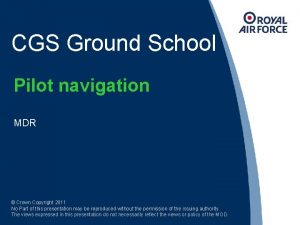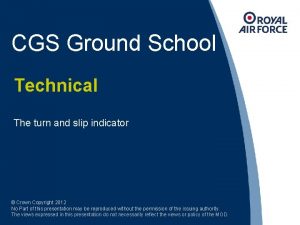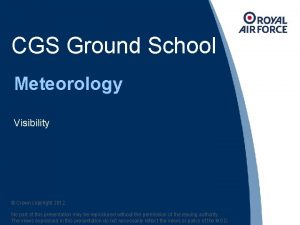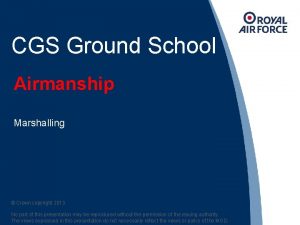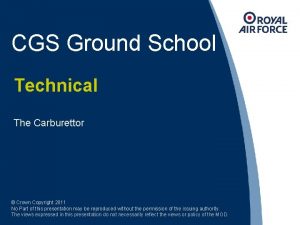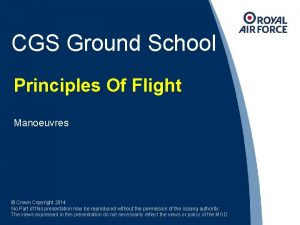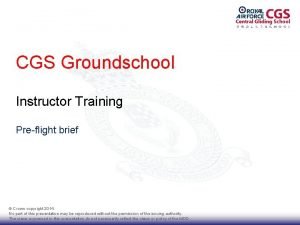CGS Ground School Instructor Training Military Air Ground















































- Slides: 47

CGS Ground School Instructor Training Military Air Ground Communication Service © Crown Copyright 2012 No Part of this presentation may be reproduced without the permission of the issuing authority. The views expressed in this presentation do not necessarily reflect the views or policy of the MOD.

Rules/Range • • Time Question Policy Notes/Handout Content. MAGCS

Aim • To revise the content of FTP 126 and CAP 452 in preparation for the Air/Ground examinations. MAGCS

Scope • We will discuss: – Rules, regulations and examinations for a MAGROCC – Procedures and Limitations – Revision of callsigns – RT procedure examples. MAGCS

MAGCS

Air Ground Radio Communication Service • An Air Ground Communication Service (AGCS) is one of three services detailed in the UK AIP which may be provided at an aerodrome • However, it is not viewed by the UK as an Air Traffic Service because it does not include an alerting service as part of its content • The AGCS provides: – Traffic information – Weather information – To pilots operating on and in the vicinity of the aerodrome • Any traffic information is based primarily on reports made by other pilots. Therefore if there is no traffic information the phrase “No reported traffic” is used. MAGCS

Air Ground Radio Communication Service • Information provided by an AGCS Radio Station Operator may be used to assist a pilot in making a decision • However, the safe conduct of the flight remains the pilot’s responsibility. MAGCS

VHF Radio Propagation and Radio Interference • VHF radio propagation, under standard tropospheric conditions, between the aircraft station and the aeronautical radio station is by a direct radio line of sight (RLOS) path which at maximum range is the sum of the distance to the radio horizon from the aircraft station and the aeronautical radio station • The following formula details the distance to the radio horizon: • D = K√ h • h = Height of antenna above ground level • K = A factor corresponding to the effective earth’s radius of 4/3 of the actual radius (1. 23 when h is expressed in feet) • D = Distance in nautical miles. MAGCS

VHF Radio Propagation and Radio Interference • A complex formula, but what it means is that radio transmissions from an aircraft flying at 3000 ft will be heard by another station located within a 67 NM radius of the aircraft’s position. MAGCS

Frequency Assignments and Designated Operational Coverage (DOC) • The CAA Surveillance and Spectrum Management are responsible for the management of aeronautical spectrum in the UK • Whilst some frequencies are pre-assigned and available for use for specific purposes, most are subject to international agreement as defined by ICAO Frequency Management Group • Reports of radio interference have been attributed to aircraft transmissions outside the DOC with whom they are in contact • Units are to ensure that aircraft under their control refrain from calling aircraft stations where they are known to be outside the DOC.

Air Navigation Order • The Air Navigation Order (ANO) Aug 12 states: “A person must not operate an aeronautical radio station for the purposes of providing an AGCS, unless they hold an AGCS Radio Operator Certificate of Competence (ROCC)” • In order to obtain a CAA ROCC the individual must pass both a written and oral examination • The Military Air Ground Radio Operator Certificate of Competence (MAGROCC) is the Service equivalent, awarded by CGS. MAGCS

MAGROCC Regulation • The rules governing the MAGROCC are contained within TGO TG(G) 2310(1) • Once a MAGROCC has been awarded there is further training required before the individual may operate the radio • The MAGROCC certificate must be kept in the individual’s training folder and the reverse of the certificate will detail the record of training. MAGCS

Unit Validation • The individual must undergo a unit validation, which will include site specific training and any local procedures • The VGS OC will then sign the reverse of the MAGROCC to state the individual is competent and understands any relevant operational information concerning the type of equipment and operating procedures • The individual will then undergo a validation by a Flying Supervisor to ensure they can operate unsupervised • The MAGROCC is then annotated accordingly. MAGCS

Currency and Standardisation • The Military Air Ground Radio Operator (MAGRO) has a currency of 3 months • Currency monitored by the Duty Instructor Watch Log and local VGS procedures • Individuals that are out of currency can regain currency through a “currency check”, a period of observation by a Flying Supervisor of no less than 30 minutes • All individuals must undergo an annual Standardisation by a Flying Supervisor, which may be completed verbally, i. e. whilst the Flying Supervisor is airborne • In all cases, MAGROCC training records must be annotated accordingly • CGS and CFS will conduct 2 nd party unit standardisation and assurance during annual visits (reflected in CGS/CFS unit reports). MAGCS

MAGCS

Procedures and Limitations • Messages shall not be transmitted to an aircraft during take-off, the last part of final approach or the landing roll, unless it is necessary for safety reasons • Personnel providing an MAGCS must ensure that they do not pass a message which could be construed to be either an Air Traffic Control (ATC) instruction, or an instruction or phrase issued by Flight Information Service Officers (FISO), such as “At your discretion” • Therefore: – G-CD take off at your discretion – Helicopter RG cleared to enter controlled airspace – Pipeline 23 report leaving the MATZ – Vortex 34 cleared to land MAGCS

Procedures and Limitations • Additionally, the following phrases must not be used by a MAGRO: – APPROVED – CLEARED – CLIMB – DESCEND – HOLD SHORT – MAINTAIN – REPORT • Since any traffic information is based primarily on reports made by other pilots, any messages where there is no traffic information must contain the phrase “No reported traffic”. MAGCS

Procedures and Limitations • Clearances initiated by an ATC unit may be relayed, but the name of the authority must be included in the message • Any relayed clearance messages must be read back, in full, by the MAGRO to the issuing authority and then by the pilot to the MAGRO: V 284, St Athan Radio, Cardiff Tower clears you to take-off for a published VFR departure to the West MAGCS

Procedures and Limitations • The MAGRO must not issue their own clearances or instructions • However, the MAGCS is a management tool for the DI and a facility for the provision of information intended to reduce the risk of an AIRPROX in the vicinity of a VGS airfield • The DI must have the ability to be able to supervise and manage personnel under their jurisdiction, especially junior pilots • Therefore any VGS instructions must be issued in the same way as Squadron operational messages and include the phrase “Your operating authority instructs you to…” – Such as: MAGCS

Procedures and Limitations V 312, Syerston Radio, your Operating Authority instructs you to divert to Waddington V 823, Odiham Radio, your Operating Authority instructs you to return to the airfield V 164, Ternill Radio, your Operating Authority instructs you to hold due to vehicle incursion V 351, Cosford Radio, your Operating Authority states negative touch and go due to authorisation V 238, Halton Radio, your Operating Authority instructs you to return to the dispersal due to. . . V 159, Henlow Radio, your Operating Authority states negative Engine Stopped Rejoin, 4 in. MAGCS

Procedures and Limitations V 312, Syerston Radio, your Operating Authority states Engine Stopped Rejoin approved, reported traffic is 1 Vigilant downwind V 823, Odiham Radio, your Operating Authority instructs you to park for refuel G 823, Radio, your Operating Authority instructs you to return to the launch point All Stations, Syerston Radio, your Operating Authority states there is no first response vehicle available and therefore no landings are to be made G 135, Arbroath Radio, your Operating Authority instructs you to land by time 35 G 823, Kirknewton Radio, your Operating Authority instructs you to return to the hangar.

Air/Ground Station Identification • A MAGRO must ensure that the full callsign, including the suffix RADIO, is used in response to the initial call from an aircraft and on any other occasion that there is doubt: – E. g. SYERSTON RADIO • After satisfactory communication has been established and providing that no confusion is likely to occur, the callsign may be abbreviated to just the location: – E. g. SYERSTON. MAGCS

Aerodrome Information and Meteorlogical conditions • Aerodrome information can be any information relating to the conditions at the aerodrome including: • QFE, QNH or RPS • Runway in use • Runway Surface Conditions • MET information is made in the form of reports: forecasts or warnings: V 284, Ternhill Radio, 0950, weather, surface wind 360 degrees 5 knots. Nil weather, 3 Oktas, QFE 1003 MAGCS

MAGCS

Aircraft Callsign Revision • An aircraft is to use the full callsign for both stations when establishing communication • A pilot may only abbreviate the callsign of his aircraft if it has first been abbreviated by the MAGRO. MAGCS

Aircraft Callsign Revision • A reminder of some abbreviated callsigns: Full Callsign GBFRM Abbreviation G-RM Speedbird GBGDC Speedbird DC N 31029 N 753 DA N 3 DA Midland 640 No abbreviation Piper GBSZT Piper ZT Helicopter GABCD Helicopter CD SYO 25 S 25 MAGCS

MAGCS

RT PROCEDURE 1 Typical RT procedure for the departure of a civilian based or visiting aircraft MAGCS

RT Procedure 1 Syerston Radio, G-ABCD radio check 125. 425 and request taxi information G-ABCD, Syerston Radio, readability 5, runway 25 left hand circuit, QFE 1010 Taxiing for 25 left hand, QFE 1010, G-ABCD G-CD, Roger G-ABCD, ready to cross runway 34 G-CD, traffic information, e. g. no reported traffic or after the Vigilant has landed no further reported traffic. MAGCS

RT Procedure 1 G-CD ready for departure G-CD , Roger. No reported traffic (or traffic information e. g. 1 Motor glider downwind). Estimated surface wind 240/20 G-CD taking off G-CD, Roger G-CD leaving the ATZ to the North, changing to Waddington 127. 350 G-CD, roger. MAGCS

RT PROCEDURE 2 Typical RT procedure for the arrival of a visiting aircraft MAGCS

RT Procedure 2 Syerston Radio, Vortex 34, Syerston Radio pass your message Syerston, Vortex 34 , Chinook, Odiham to Syerston, overhead Nottingham, heading 040, 3000 ft, Barnsley 1012, estimating Syerston in 5 minutes, request joining information Vortex 34, runway 24 R/H, surface wind 240/10, QFE 1001, no reported traffic (or traffic is 1 Vigilant in circuit). MAGCS

RT Procedure 2 Roger, will report joining downwind Vortex 34, Roger Vortex 34 downwind to land Vortex 34, Roger. Traffic is 1 Vigilant short final Roger, Vortex 34, final Vortex 34, Roger. Surface wind 220/10 Roger, Vortex 34. MAGCS

RT Procedure 2 Vortex 34, runway vacated Vortex 34, parking available on HLS North Vortex 34, Roger. MAGCS

RT PROCEDURE 3 Typical RT procedure for an aircraft transiting close to the airfield MAGCS

RT Procedure 3 Syerston Radio, G-BBMC, Syerston Radio, pass your message Syerston, G-BBMC, Jodel, Nottingham to Gamston, 3 miles West of Syerston, heading 015, 2000 ft on 1022, request Basic Service G-MC, Roger. Basic Service unavailable, Syerston Radio only. Runway 06 is active left hand for light aircraft with 1 Vigilant reported departing to the West. MAGCS

RT Procedure 3 Right hand for winch launched gliders, cables possible up to 3000 ft , 1 Viking reported ready for launch G-MC, Roger. Will avoid your ATZ and route to the North G-MC, Roger. MAGCS

RT PROCEDURE 4 Typical RT response to a distress (or urgency) radio call MAGCS

RT Procedure 4 Mayday, Syerston Radio, G-ABCD, Syerston Radio, your Mayday is acknowledged, pass your details. MAGCS

RT Procedure 4 Mayday, G-ABCD, 3 miles North of Syerston, heading 175, 3000 ft, 1012, Robin, 2 POB, Engine fire, intend land at Syerston G-CD, Roger. Runway 24 left hand is active, surface wind 240/20, QFE 1010, all runways are available Roger , G-CD. MAGCS

RT Procedure 4 • All other aircraft on frequency should maintain RT silence on hearing the emergency call. If they do not then request radio silence: - “All Stations, Syerston Radio, Stop Transmitting, Mayday in progress“ • It may be appropriate to request that all other aircraft land or vacate the circuit: - “All Stations, Syerston Radio, your Operating Authority instructs you to remain clear of the circuit until further notice“ • Inform the FRV Crew/Duty Exec as appropriate. MAGCS

MAGCS

Summary • We have discussed: – Rules, regulations and examinations for a MAGROCC – Procedures and Limitations – Revision of callsigns – RT procedure examples. MAGCS

Aim • To revise the content of FTP 126 and CAP 452 in preparation for the Air/Ground examinations. MAGCS

Link and References • Link: – N/A • References: – CAP 413 – CAP 452 – FTP 126. MAGCS

Any Final Questions MAGCS

Thank you! RT Procedures
 Hubungan air dengan tanah
Hubungan air dengan tanah Military training network bls
Military training network bls Aixm training
Aixm training Commander intent example
Commander intent example Cgs 3269
Cgs 3269 Cgs 2531 uf
Cgs 2531 uf Thomas nedorost
Thomas nedorost Cgs 3763
Cgs 3763 Cse 598
Cse 598 Cgs 3763
Cgs 3763 Cgs 3175
Cgs 3175 Cgs 2100
Cgs 2100 Cgs2518 fsu
Cgs2518 fsu Cgs medicare credit balance report
Cgs medicare credit balance report Cgs cusip
Cgs cusip Cgs 3763
Cgs 3763 Cgs 3763
Cgs 3763 Cgs 3269
Cgs 3269 Cgs css
Cgs css Cal maritime uniforms
Cal maritime uniforms Training ground rules
Training ground rules Norfolk mappa
Norfolk mappa Tipos de participantes y sus características
Tipos de participantes y sus características Basic instructor course texas
Basic instructor course texas Basic instructor course texas
Basic instructor course texas Basic instructor course texas
Basic instructor course texas Pepperball training manual
Pepperball training manual Neither of my two suitcases are adequate for this trip
Neither of my two suitcases are adequate for this trip Instructor vs teacher
Instructor vs teacher Cisco certified instructor
Cisco certified instructor Mptc firearms instructor
Mptc firearms instructor Tcole advanced instructor course
Tcole advanced instructor course Basic instructor course #1014
Basic instructor course #1014 Drawing and painting the virtual instructor
Drawing and painting the virtual instructor Nfpa 1403
Nfpa 1403 Human factors instructor
Human factors instructor Instructor operating station
Instructor operating station Catia instructor
Catia instructor Instructor
Instructor Ac61-98 plan of action
Ac61-98 plan of action Tcole 1014 basic instructor course
Tcole 1014 basic instructor course Njrotc instructor vacancies
Njrotc instructor vacancies How to become an nrp instructor mentor
How to become an nrp instructor mentor Utp cable
Utp cable Cbrf instructor registry
Cbrf instructor registry Nra certified instructor logo
Nra certified instructor logo Naismith was an instructor of
Naismith was an instructor of Please clean your own room
Please clean your own room

